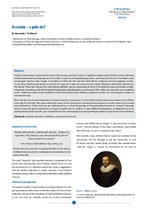| dc.contributor.author | Muntingh, G. L. | |
| dc.contributor.author | Viljoen, M. | |
| dc.date.accessioned | 2017-07-17T09:55:38Z | |
| dc.date.available | 2017-07-17T09:55:38Z | |
| dc.date.issued | 2017 | |
| dc.identifier.citation | Muntingh, G. L. & Viljoen, M. (2017). Anaemia – a pale ale? South African Family Practice, 59(3): 17-23 | en_US |
| dc.identifier.issn | 2078-6190 | |
| dc.identifier.uri | http://hdl.handle.net/10566/3088 | |
| dc.identifier.uri | http://www.safpj.co.za/index.php/safpj/article/view/4688 | |
| dc.description.abstract | Despite some modest improvements described recently, anaemia remains a significant global public health concern affecting
both developed and developing countries. It affects a quarter of the global population, including 293 million (47%) children who
are younger than five years of age. A prevalence of 42% and 30% has been described in pregnant and non-pregnant women,
respectively. Children and women of reproductive age are at high risk, partly because of physiological vulnerability, followed by
the elderly. Africa and Asia are the most heavily affected regions, accounting for 85% of the absolute anaemia burden in highrisk
groups. According to the World Health Organization global database on anaemia (1993–2005), this disorder was considered
to be a moderate public health problem in South African preschool children, pregnant women and non-pregnant women of
reproductive age. | en_US |
| dc.language.iso | en | en_US |
| dc.publisher | Cogent OA | en_US |
| dc.rights | Open Access article distributed under the terms of the Creative Commons License [CC BY-NC-ND 4.0] http://creativecommons.org/licenses/by-nc-nd/4.0 | |
| dc.subject | Anaemia | en_US |
| dc.subject | Blood film | en_US |
| dc.subject | Evaluation | en_US |
| dc.subject | Macrocytic | en_US |
| dc.title | Anaemia – a pale ale? | en_US |
| dc.type | Article | en_US |
| dc.privacy.showsubmitter | FALSE | |
| dc.status.ispeerreviewed | TRUE | |

